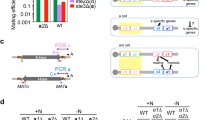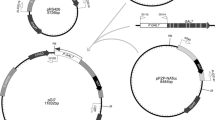Abstract
The 293-amino acidmt A-1 ORF of theA mating-type idiomorph ofNeurospora crassa is multifunctional. It confersA mating identity and is responsible for heterokaryon incompatibility. The goal of this study was to dissect the functional regions ofmt A-1. New mutants ofmt A-1 selected for loss of the incompatibility function were obtained. One new mutant,A m99, was partially fertile as a maternal parent. This is the first time that fertility and incompatibility functions have been separated for theA idiomorph. In this mutant, themt A-1 ORF is truncated after the first 85 amino acids, indicating that this N-terminal region is minimally sufficient for female fertility. A series of deletion constructs and frameshift alleles ofmt A-1 was obtained and tested for male-mating activity and vegetative incompatibility in transformation experiments. These experiments showed that a region from position 1 to 111 is sufficient to confer incompatibility, while amino acids from position 1 to 227 are required for mating activity. A transcriptional analysis ofmt A-1 showed that the mRNA is expressed both before and after fertilization. This, together with the phenotype of theA m99 mutant, suggests a post-fertilization function formt A-1.
Similar content being viewed by others
References
Arnaise S, Zickler D, Glass NL (1993) Heterologous expression of mating-type genes in filamentous fungi. Proc Natl Acad Sci USA 90:6616–6620
Astell CR, Ahlstrom-Jonasson L, Smith M, Tatchell K, Nasmyth KA, Hall BD (1981) The sequence of the DNAs coding for the mating-type loci ofSaccharomyces cerevisiae. Cell 27:15–23
Beadle GW, Coonradt VL (1944) Heterokaryosis inNeurospora crassa. Genetics 29:291–308
Bistis GN (1983) Evidence for diffusible, mating-type-specific trichogyne attractants inNeurospora crassa. Exp Mycol 7:292–295
Brockman HE, Deserres FJ, Ong TM, Hung CY (1987) Two N-hydroxylaminopurines are highly mutagenic in thead-3 forward-mutation test in growing cultures of heterokaryon 12 ofNeurospora crassa. Mutat Res 177:61–75
Bruchez JJP, Eberle J, Russo VEA (1993) Regulatory sequences in the transcription ofNeurospora crassa genes: CAAT box, TATA box, introns, poly(A) tail formation sequences. Fungal Genet Newslett 40:89–96
Carrol AM, Sweigard JA, Valent B (1994) Improved vectors for selecting resistance to hygromycin. Fungal Genet Newslett 41:22
Casselton LA (1993) Fungal mating type genes — regulators of sexual development. Mycol Res 96:993–1006
Chang S, Staben C (1994) Directed replacement ofmt-A bymt a-1 effects a mating-type switch inNeurospora crassa. Genetics 138:75–81
Debuchy R, Coppin E (1992) The mating types ofPodospora anserina: functional analysis and sequence of the fertilization domains. Mol Gen Genet 233:113–121
Devereux J, Haeberli P, Smithies O (1984) A comprehensive set of sequence analysis programs for the VAX. Nucleic Acids Res 12:387–395
Dodge BO (1935) The mechanics of sexual reproduction inNeurospora. Mycologia 27:418–436
Edelman S, Staben C (1994) A statistical analysis of sequence features within genes fromNeurospora crassa. Exp Mycol 18:70–81
Fourney RM, Miyakoshi J, Day RS, Paterson MC (1988) Northern blotting: efficient RNA staining and transfer. Focus 10:5–7
Frohman MA, Dush MK, Martin GR (1988) Rapid production of full-length cDNAs from rare transcripts: amplification using a single gene-specific oligonucleotide primer. Proc Natl Acad Sci USA 85:8998–9002
Glass NL, Kuldau GA (1992) Mating type and vegetative incompatibility in filamentous ascomycetes. Annu Rev Phytopathol 30:201–224
Glass NL, Lee L (1992) Isolation ofNeurospora crassa A mating type mutants by repeat induced point mutation. Genetics 132:125–133
Glass NL, Nelson MA (1994) Mating-type genes in mycelial ascomycetes. In: Wessels JDH, Meidhardt F (eds) The Mycota: growth, differentiation and sexuality. Springer, Berlin New York Heidelberg pp 295–306
Glass NL, Staben C (1990) Genetic control of mating inNeurospora crassa. Semin Dev Biol 1:177–184
Glass NL, Vollmer SJ, Staben C, Grotelueschen J, Metzenberg RL, Yanofsky C (1988) DNAs of the two mating-type alleles ofNeurospora crassa are highly dissimilar. Science 241:570–573
Glass NL, Grotelueschen J, Metzenberg RL (1990)Neurospora crassa A mating-type region. Proc Natl Acad Sci USA 87:4912–4916
Griffiths AFJ (1982) Null mutants of theA and a mating-type alleles ofNeurospora crassa. Can J Genet Cytol 24:167–176
Griffiths AJF, Delange AM (1978) Mutations of the a mating type inNeurospora crassa. Genetics 88:239–254
Hagen DC, Bruhn L, Westby CA, Sprague GF Jr (1993) Transcription of a-specific genes inSaccharomyces cerevisiae: DNA sequence requirements for activity of the coregulatorα1. Mol Cell Biol 13:6866–6875
Herskowitz I (1988) Life cycle of the budding yeastSaccharomyces cerevisiae. Microbiol Rev 52:536–553
Logemann J, Schell J, Willmitzer L (1987) Improved method for isolation of RNA from plant tissues. Anal Biochem 163:16–20
Metzenberg RL, Glass NL (1990) Mating type and mating strategies inNeurospora. Bio essays 12:53–59
Newmeyer D (1970) A suppressor of the heterokaryon-incompatibility associated with mating type inNeurospora crassa. Can J Genet Cytol 12:914–926
Philley ML, Staben C (1994) Functional analysis of theNeurospora crassa MT a-1 mating type polypeptide. Genetics 137:715–722
Saiki RK, Gelfand DH, Stoffel S, Scharf SJ, Higuchi R, Horn GT, Mullis KB, Ehrlich HA (1988) Primer directed enzymatic amplification of DNA with a thermostable DNA polymerase. Science 239:487–491
Sanger F, Nicklen S, Coulson AR (1977) DNA sequencing with chain-terminating inhibitors. Proc Natl Acad Sci USA 74:5463–5467
Schweizer M, Case ME, Dykstra CC, Giles NH, Kushner SR (1981) Identification and characterization of recombinant plasmids carrying the completeqa gene cluster fromNeurospora crassa including theqa-1 + regulatory gene. Proc Natl Acad Sci USA 78:5086–5090
Staben C, Yanofsky C (1990)Neurospora crassa a mating-type region. Proc Natl Acad Sci USA 87:4917–4921
Stevens JN, Metzenberg RL (1982) Preparing Neurospora DNA: some improvements. Neurospora Newslett 29:27–28
Tan S, Richmond TJ (1990) DNA binding-induced conformational change of the yeast transcriptional activator PRTF. Cell 62:367–377
Tan S, Ammerer G, Richmond TJ (1988) Interactions of purified transcription factors: binding of yeast MATα1 and PRTF to cell-type specific, upstream activating sequences. EMBO J 7:4255–4264
Turgeon BG, Bohlmann H, Ciuffetti LM, Christiansen SK, Yang G, Schafer W, Yoder OC (1993) Cloning and analysis of the mating type genes fromCochhobolus heterostrophus. Mol Gen Genet 238:270–284
Vellani TS, Griffiths AJF, Glass NL (1994) New mutations that suppress mating-type vegetative incompatibility inNeurospora crassa. Genome 37:249–255
Vogel HJ (1964) Distribution of lysine pathways among fungi: evolutionary implications. Am Nat 98:435–466
Vollmer SJ, Yanofsky C (1986) Efficient cloning of genes ofNeurospora crassa. Proc Natl Acad Sci USA 83:4869–4873
Westergaard M, Mitchell HK (1947)Neurospora V. A synthetic medium favoring sexual reproduction. Am J Bot 34:573–577
Yuan YO, Stroke IL, Fields S (1993) Coupling of cell identity to signal response in yeast: interaction between theα1 and STE12 proteins. Genes Dev 7:1584–1597
Author information
Authors and Affiliations
Additional information
Communicated by C. A. M. J. J. Van den Hondel
Rights and permissions
About this article
Cite this article
Saupe, S., Stenberg, L., Shiu, K.T. et al. The molecular nature of mutations in themt A-1 gene of theNeurospora crassa A idiomorph and their relation to mating-type function. Molec. Gen. Genet. 250, 115–122 (1996). https://doi.org/10.1007/BF02191831
Received:
Accepted:
Issue Date:
DOI: https://doi.org/10.1007/BF02191831




